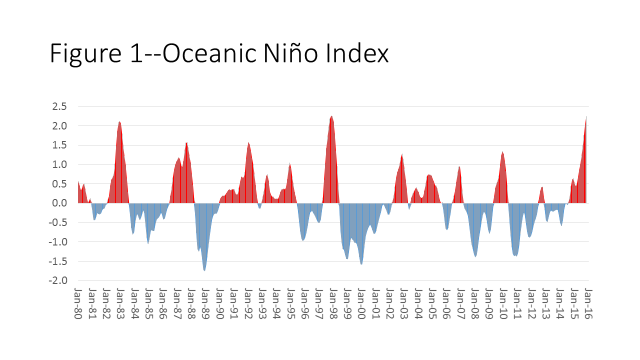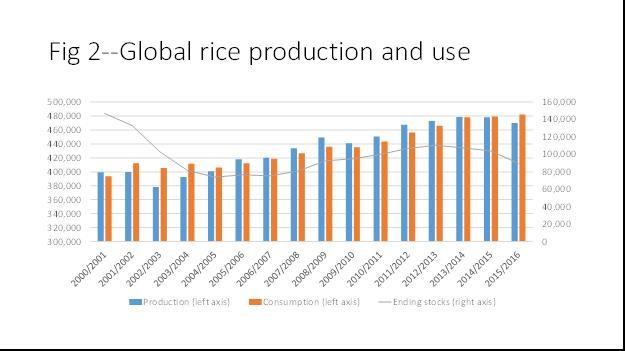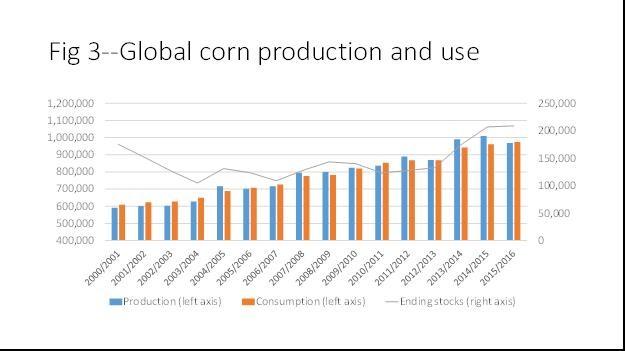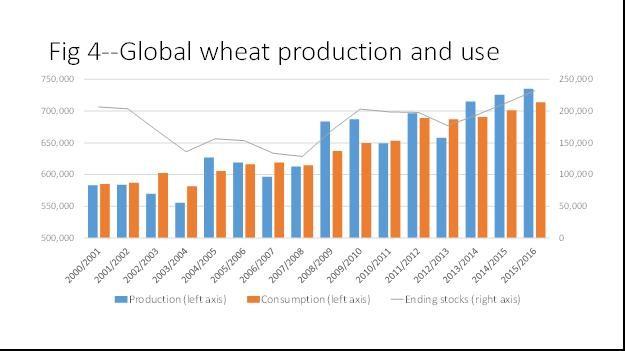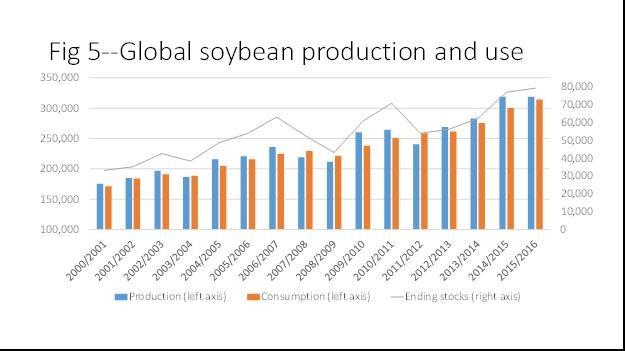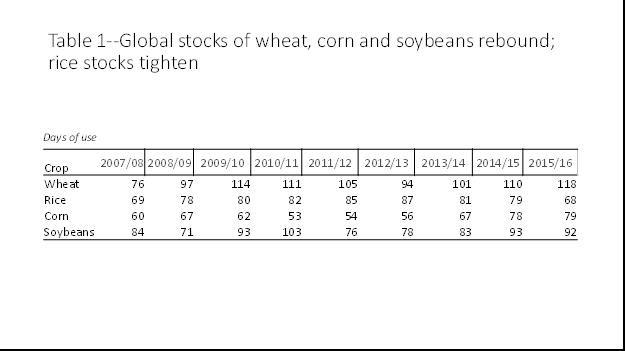
By: Joseph Glauber, IFPRI
A strong El Niño continued through December, as indicated by above-average sea surface temperatures (SST) across the central and eastern equatorial Pacific Ocean. The strength and duration of the current El Niño event has raised concerns about global crop prospects and food prices.
The El Niño–Southern Oscillation (ENSO) is an irregularly periodical climate change caused by variations in SSTs over the tropical eastern Pacific Ocean, affecting much of the tropics and subtropics. The warming phase is known as El Niño, while the cooling phase is called La Niña. The Southern Oscillation is an accompanying atmospheric component, coupled with the sea temperature change: El Niño is accompanied with high, and La Niña with low, air surface pressure in the tropical western Pacific. The two periods last several years each (typically three to four) and their effects vary in intensity. (For more information on the ENSO cycle in general and this year’s cycle in particular, visit the US National Oceanic and Atmospheric Administration’s (NOAA) El Niño portal .)
The Oceanic Niño Index (ONI) is an index based on SST departures from average in the Niño 3.4 region (Central Pacific) and is a principal measure for monitoring, assessing, and predicting El Niño Southern Oscillation (ENSO). The ONI is defined as the three-month running-mean SST departures in the Niño 3.4 region. El Niño conditions are characterized by a positive ONI greater than or equal to +0.5ºC. La Niña, its cold-water counterpart, is characterized by a negative ONI less than or equal to -0.5ºC. By historical standards, to be classified as a full-fledged El Niño or La Niña episode, these thresholds must be exceeded for a period of at least five consecutive overlapping three-month seasons.
The current El Niño began in late winter/early spring of 2015. The ONI for the three-month running average of October-December 2015 was 2.25, the ninth consecutive month in which the ONI had exceeded 0.5 and represented the highest level seen since the same period in 1997 (figure 1). NOAA’s Climate Prediction Center continues to predict that the strong El Niño will continue through the Northern Hemisphere winter 2015-16, followed by weakening and transitioning to ENSO-neutral during the late spring or early summer.
What does this mean for global agriculture? The impact of El Niño conditions on agriculture depends on the event’s timing and duration, as well on the sensitivity of specific crops to adverse weather during this period. For example, El Niño has already contributed to dry growing conditions in Southern Africa, which has reduced the size of the region’s corn crop and has been in part responsible for the drought in the Horn of Africa. Similarly, drier than average conditions this summer in South East Asia have had a negative impact on rice yields in the region.
El Niño has brought wetter and colder weather to the southern United States throughout late 2015 and early 2016. These rains have helped alleviate dry conditions in the Mid-South, and large snowfalls have brought much needed precipitation to the Sierra Nevada mountains, which will help mitigate the severe drought in California.
The overall effects of El Niño on global agriculture are difficult to predict because of the complex interactions between the atmosphere and the ocean and the phases of crop development. For example, rainfall in September-October was below average for most of Australia; this is consistent with previous El Niño events, such as that seen in 2006 when Australian crops suffered large yield losses. However, average to above-average precipitation during the late fall has since boosted yield prospects in the region. Rice yields in many Asian countries, such as Vietnam and Indonesia, show little impact from El Niño, at least in the aggregate numbers.
At the same time, the El Niño cycle does appear to be having an impact in other regions; India , for example, is experiencing warmer than average temperatures and below-average winter rains that are, at least in part, being driven by the current El Niño cycle. These abnormal weather patterns are expected to impact the region’s wheat crop. Wheat planting in India is already 27 percent lower than last year’s levels, and experts expect wheat production to fall below 90 million tonnes.
While rice yields in some individual countries remain unaffected, as discussed above, the latest World Agricultural Supply and Demand Estimates report from the US Department of Agriculture show a decline in global rice and corn production in 2015-16 compared to the previous year, in part due to El Niño and in part due to lower plantings (for example, US corn). Global soybean production is anticipated to match last year's record levels.
Global wheat production for 2015-16, much of which was harvested before the onset of El Niño, is also projected at a record level; however, this is due largely to large increases in production in two countries (Russia and Pakistan), and a slightly smaller increase in production in the EU. As shown above in the case of India, production at the regional and country levels can differ significantly.
For maize, continuing drought in both Central America and the Caribbean and South Africa is contributing to lower global ending stocks, which are predicted to be 2.9 million tons lower than last year. In <Honduras , corn farmers have lost as much as 80 percent of their crop due to dry conditions. There are concerns regarding how the continuing El Niño event will impact early 2016 plantings throughout the region.
Table 1 shows projected global ending stocks for wheat, rice, corn, and soybeans for 2015-16, expressed as days of use. With the exception of rice, the other crops show stock levels near or above the previous year's level and significantly above 2006-07 levels. Rice stock levels, however, have fallen as a percent of use due to increasing global demand and lower global production.
Increased stock levels have contributed to lower prices for cereals and oilseeds in world markets. Cereals prices in December, as reported by FAO , were 18 percent lower than levels one year ago and were the lowest since spring 2010.
Thus far, despite the effects of El Niño global supplies are projected to be plentiful. However, as highlighted here, the local impacts across the world could be quite significant. In addition, the potential impacts of El Niño on fall and spring planted crops will need to be monitored closely over the next several months.
Follow full coverage of the 2015-2016 El Niño cycle, both globally and regionally, with the Food Security Portal:
El Niño Driving Abnormal Weather Patterns, Food Security Concerns Worldwide
El Niño Raises Concerns about Food Security as Millions Face Threat of Drought, Floods
Situación alimentaria y climática en Centroamérica
Perspectiva climática regional hasta marzo 2016
Regional SSA Updates from FEWS.Net
FEWS.Net Report Predicts Flooding for Horn of Africa
Ethiopia Facing Severe Drought
Ethiopia’s 2015 Drought: No Reason for a Famine
High Temps and Dry Conditions Delay Planting, Raise Production Concerns
India Experiences Driest Monsoon in Six Years
Warmest Months on Record
Joseph Glauber is a Senior Research Fellow at the International Food Policy Research Institute (IFPRI) in Washington, DC. Prior to joining IFPRI, Glauber served as Chief Economist for the U.S. Department of Agriculture. From 2007 to 2009, Glauber was the chief agricultural negotiator in the Doha talks for the office of the U.S. Trade Representative.
Files:
- corn_prod_use_jan2016.jpg
- global_stocks_jan2016.jpg
- oceanic_nino_index.png
- rice_prod_use_jan2016.jpg
- soybean_prod_use_jan2016.jpg
- wheat_prod_use_jan2016.jpg
